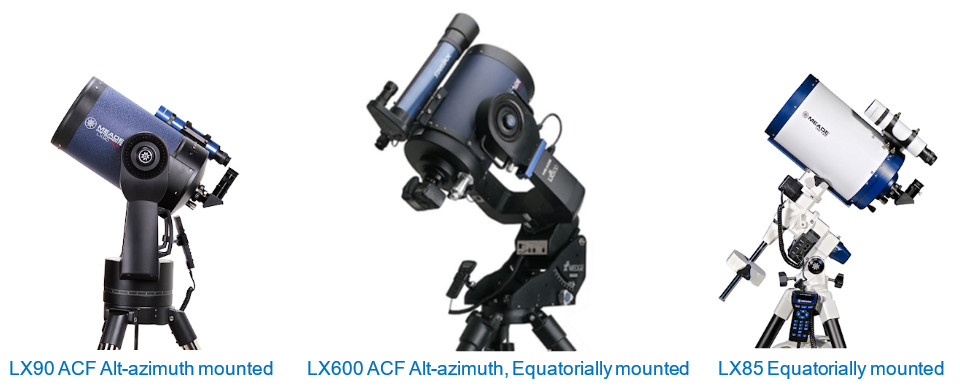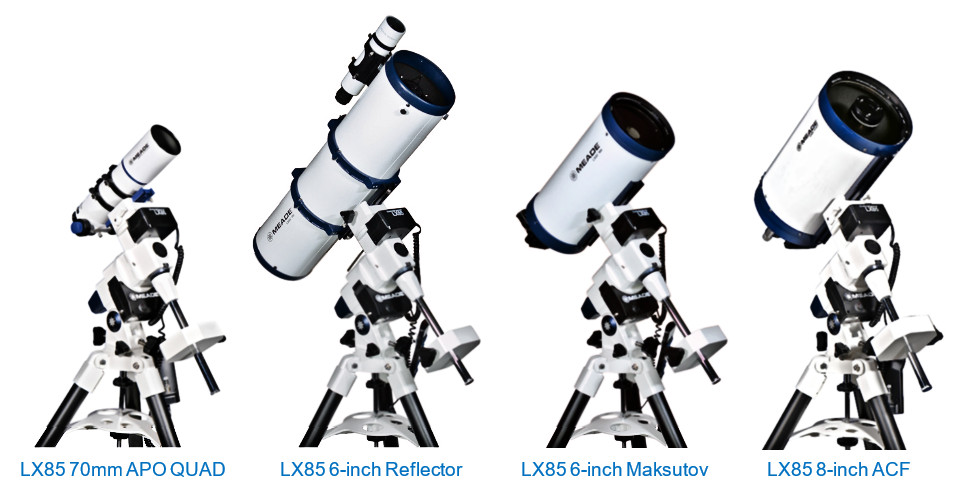Introduction
This article is for those interested in purchasing their second telescope or for people that are new to astronomy but wish to buy a more advanced and larger telescope from day one. The article focuses on telescopes that offer an excellent price-performance ratio in terms of quality, aperture, optics, mount options and controls.
Mid-price telescopes like the ones discussed in this article can be purchased as a complete package or bought in parts in terms of the Optical Tube Assembly (OTA), mount, accessories etc.
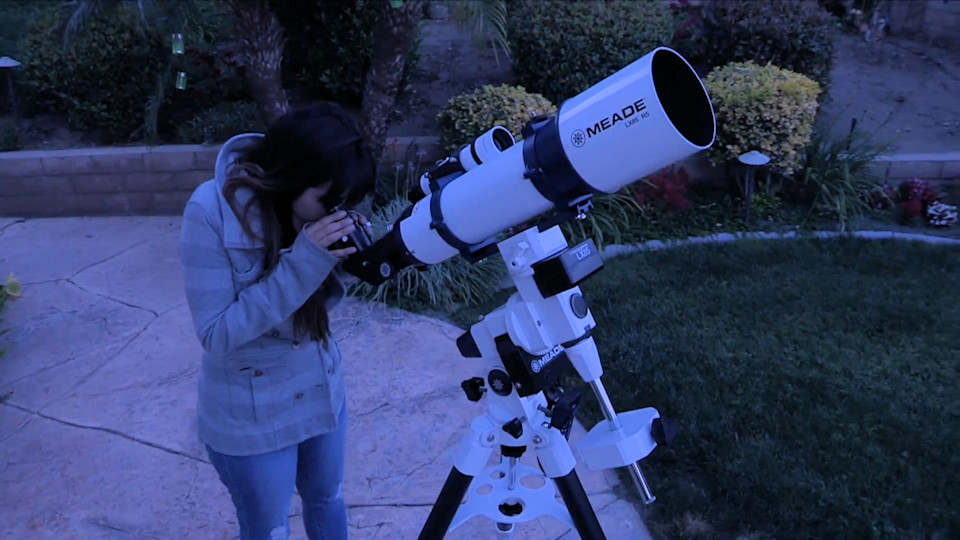
Meade LX85 5-inch Achromatic Refractor telescope.
The article focuses on and outlines the Meade ETX125 Observer telescope and LX65, LX85, LX90, LightSwitch LS and LightBridge Series. With the exception of the manually controlled LightBridge Dobsonian telescopes and LightSwitch LS that uses its dedicated AutoStar III handset, all other telescopes in this article come with the Meade AudioStar computerised handset.
The AudioStar handset features audio files and an internal speaker. This computerised celestial object locating system plugs into the telescope's handset port allowing for quick telescope alignment.
Once aligned with the sky, the AudioStar is ready to take you to any object in the over 30,000 object database. In addition to GOTO and auto-tracking capability the AudioStar offers a wide array of recreational and educational functions such as multiple Guided Tours, digital positional readouts, the ability to link with a PC or tablet using an optional cord/wireless adapter and software.
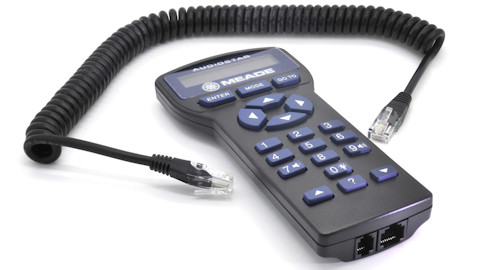
Meade AudioStar computerised handbox.
Once aligned, GOTO telescopes are very attractive as they can automatically locate and then track Celestial objects including planets, the Moon, stars, galaxies and nebulae among others.
Optical tube assemblies
There are mainly three types optical tube assemblies (OTA) namely, Newtonian reflectors, catadioptrics and refractors. Variations of these designs exist and we will refer to some of these in the course of this article. For additional information on these three telescope types please refer to the article headed Choosing your first telescope (in the Links section below).
All designs can be used for observation or imaging but depending on your requirements certain designs will be better suited for a particular application.
Refractor telescopes
High quality apochromatic (APO) refractors using extra low distortion (ED) glass are ideal for planetary observation and for deep sky imaging in particular. They do however require longer exposure times when compared to equally priced, larger aperture catadioptric telescopes or reflectors of the same focal ratio when imaging deep sky objects. While an APO would readily surpass any reflector of catadioptric telescope of the same or similar aperture it would do that at a comparatively high cost and physical size.
Apochromatic refractors, show increased detail when compared to catadioptrics and reflectors of the same or similar aperture mainly due to their optical design and luck of a central obstruction. They also deliver even higher quality images when compared to Newtonian reflectors that in addition suffer from tube currents and diffraction caused by the secondary mirror supports.
Unlike Newtonian telescopes, refractors hold their collimation exceptionally well, have shorter cooling-down times and require minimal maintenance. Apochromatic refractors use high quality ED glass that all but eliminates chromatic aberration while raising contrast and the apparent level of detail.
Achromatic refractors on the other hand suffer from chromatic aberration and limited magnification. Depending on their focal ratio, expect practical magnifications of around 30-35x per inch of aperture for achromatic refractors compared to 60x times for APOs.
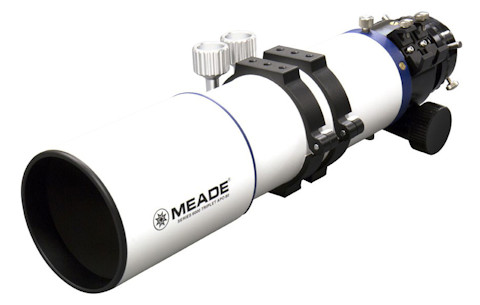
Meade Series 6000 80mm APO.
Catadioptric telescopes
Catadioptric telescopes like Schmidt Cassegrain and Maksutov type designs offer a compact telescope making even an 8-inch aperture instrument relatively easy to handle. Such telescopes, hold their collimation well, their optics are protected from the elements and offer good to very good overall optical performance depending on the design. Maintenance is minimal as is the need for collimation.
Maksutov-Cassegrain telescopes
Maksutov telescopes feature the Maksutov-Cassegrain optical design for pinpoint star images and high level of contrast, making this design ideal for detailed Lunar and planetary observation.
The long focal ratios, typical of this design, do not make them very well suited for deep sky work but deep sky objects of small apparent size would still benefit from the longer focal lengths this design offers.
Maksutov telescopes become unwieldy above 7-inches aperture and prices rise dramatically as does their weight.
Expect maximum practical magnifications of around 35x-45x per inch of aperture depending on the telescope’s focal ratio. Higher focal ratios (F/15) will yield higher effective magnifications i.e., 40x-45x.
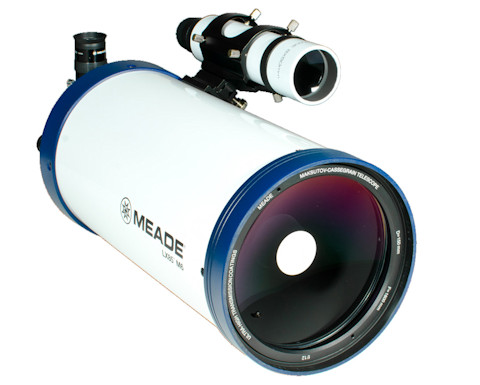
Meade LX85 6-inch Maksutov-Cassegrain.
Schmidt-Cassegrain telescopes (SCT)
Traditional SCT telescopes perform well and have several advantages compared to say a Newtonian reflector. SCT optical tubes are lighter than a same aperture Newtonian reflector, are less affected by the wind, hold collimation well, are not subject to tube currents and their optics are protected behind the frontal corrector plate. Expect maximum practical magnifications of 30x per inch of aperture, similar to a well collimated Newtonian reflector telescope. Meade Instruments no longer manufactures or supplies SCT type telescopes, these have been superseded by the Meade ACF optical design.
Meade Advanced Coma Free (ACF) telescopes
Meade has significantly improved on the old Schmidt Cassegrain (SCT) design by the introduction of Advanced Coma Free (ACF) optics. The ACF design offers exceptional optical performance across the whole field of view unlike SCT telescopes where coma is present and readily detectable as you move away from the centre of the field of view.
Using this Meade exclusive design, making ACF optics equal to Ritchey-Chrétien systems, ACF achieve aplanatic performance - with a flatter field, reduced astigmatism and no diffraction spikes.
The ACF design realises this partially via the use of aspherical reflective optics and without additional corrector lenses that are subject to light loss, optical aberrations and extended cooling times. Expect maximum practical magnifications of 40x per inch of aperture.
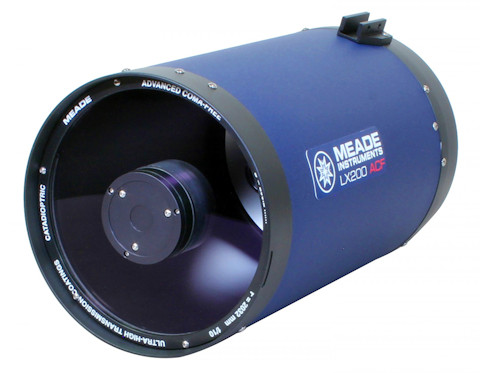
Meade LX200 F/10 8-inch ACF.
Meade ACF optical tubes use the same advanced Meade optics but the range of accessories, finish, aperture, focal ratios mechanical features may vary. ACF optical tubes come in F/10 and F/8 focal ratios making them general-purpose. They are available separately or as part of a complete telescope.
Optical
Tube |
Optical
Coatings |
Focal Ratio |
Aperture
(inches) |
Dual Speed
Focuser |
Mirror Lock |
Cooling Fan |
| LX65 ACF |
UHTC* |
F/10 |
6, 8 |
- |
- |
- |
| LX85 ACF |
UHTC* |
F/10 |
6, 8 |
|
|
|
| LX90 ACF |
UHTC* |
F/10 |
8, 10, 12 |
- |
- |
- |
| LX200 ACF |
UHTC* |
F/10 |
8, 10, 12, 14, 16 |
- |
yes |
16-inch |
| LX600 ACF |
UHTC* |
F/8 |
10, 12, 14, 16 |
yes |
yes |
16-inch |
| * Ultra High Transmission Coatings (UHTC) |
Reflector telescopes
Newtonian reflecting telescopes make ideal imaging telescopes for the serious but budget minded amateur astronomer that wishes to venture in deep sky astro-photography. These telescopes require some maintenance in terms keeping the optics clean and well collimated. While a well collimated reflector can deliver good quality images, an out of collimation reflector would not perform as well. Fortunately, collimation can be assisted by small affordable tools like the Cheshire eyepiece and/or a laser collimator.
Reflectors offer very good value in terms of aperture, faster focal ratios and do not suffer from chromatic aberrations. This is because light is reflected off a mirror surface and does not pass through a lens.
They do however suffer from coma and a coma corrector for focal ratios F/5 and especially F/4 and below would be desirable for deep sky imaging.
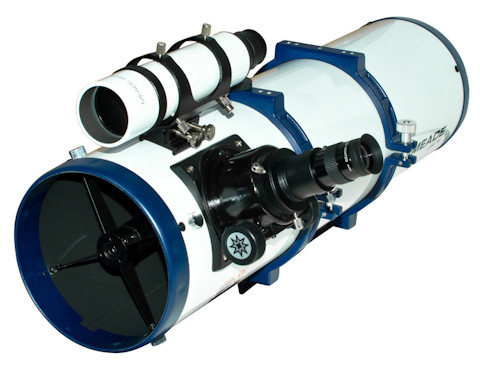
Meade LX85 6-inch F/5 Reflector.
Summary
If wide field deep sky imaging and Lunar/planetary observation were of interest an APO refractor would be ideal. If Lunar/planetary observation and imaging was of interest Maksutov Cassegrain telescopes would be well suited. If you were after a high-quality general-purpose telescope for both observation and imaging of the Moon, planets and deep sky objects an F/8 or F/10 ACF is rather difficult to beat. Finally, a Newtonian reflector is a good, affordable telescope that will perform well whether you observe or image through it.
Ultimately, an optical tube would need to be mounted to be of use. The next section looks at computerised mounts that can be controlled via a computerised handset that is supplied with the mount/telescope.

Meade LX65 6-inch Maksutov telescope.
Telescope mounts
In general, there are two main types of mounts, German Equatorial and Alt-azimuth.
Equatorially mounted telescopes are ideal for deep sky imaging purposes but there is very little to choose between an equatorially mounted and an Alt-azimuth mounted telescope when used for visual observation or planetary and Lunar imaging.
Computerised mounts will automatically locate and accurately track night sky objects like the Moon, planets, nebulae, stars and galaxies for visual and imaging purposes.
In addition, computerised equatorially mounted telescopes generally facilitate auto-guiding that extends exposure times limited only by the specification and capability of the camera used.
Furthermore, equatorially mounted telescopes eliminate field rotation by design, eliminating field rotation in necessary for deep sky imaging.

Meade equatorial wedge.
Meade alt-azimuth mounts
Alt-azimuth mounts are relatively easy to setup and align and do not require counter-weights that equatorial mounts need to balance the load. Certain Alt-azimuth mounts can still be set to equatorial mode through the addition of a wedge at a later date. The LX65 mount does not currently support a wedge.
Meade supplies the LX65 series Alt-azimuth mount separately or as a complete telescope with an optical tube of your choice. The LX65 mount is very well suited for observation, planetary and Lunar imaging as well as for introductory deep sky imaging.
The main advantage of the LX65 is that this mount can lift two optical tubes of your choice at once, subject to load limitations i.e., up to an 8” ACF (6.8Kg max) and up to an 80mm refractor or 5-inch catadioptric (3.2Kg max).
The LX65 is available as a stand-alone mount or as a complete telescope with a choice of Maksutov-Cassegrain or ACF optical tubes.
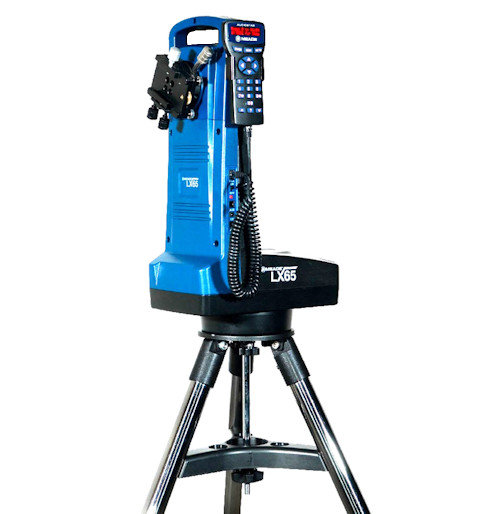
LX65 mount.
Meade equatorial mounts
Meade supplies two computerised equatorial mounts, the advanced medium capacity LX85 and the state-of-the-art high-capacity LX850 that is outside the scope of this article. Once Polar aligned, these equatorial mounts are ready for deep sky imaging enabling long exposures, eliminating field rotation and offering the option for auto-guiding.
The LX85 is a high quality, portable, GoTo, equatorial mount with the AudioStar handset, ideal for both imaging and astro-photography. The LX85 mount has an ST-4 compatible auto-guide port, servo motors with encoders on both axes and Permanent Periodic Correction (PPEC) features typically present in mounts costing significantly more. The LX85 features a Vixen-style saddle, for optical tubes up to 15kg, coupled with a sturdy build, that ensure smooth tracking performance.
Other noteworthy features include integer gearing in the motor drive enabling particularly long exposures using PPEC and no Meridian flip while the powerful servo motors will handle slight load imbalances with ease.
The LX85 can auto-guide that will extend exposures to those beyond the capabilities of most if not all astronomy cameras. Note that for auto-guiding you would need a secondary small instrument (e.g., Meade Series 6000 guide-scope) attached to the primary imaging telescope and also an auto-guide camera (e.g., Meade LPI-G). These two items are optional and would need to be purchased separately.
The LX85 is available as a stand-alone mount or as a complete telescope with a variety of optical tubes including a 5-inch achromatic refractor, an 80mm APO refractor, a 115mm APO refractor, a dedicated 70mm APO imaging refractor, a 6-inch Maksutov Cassegrain, 6-inch and 8-inch Newtonian reflector and 6-inch and 8-inch ACF.

LX85 mount.
Meade alt-azimuth mounted telescopes
Meade produce the most advanced fully featured fork-mounted telescopes including their ETX Observer, LX65, LX90 ACF and the more advanced LX200 ACF and LX600 ACF Series that are beyond the scope of this article. The LX65, LX90 and ETX Observer come with the latest AudioStar computerised handset that features a built-in library of 30,000+ objects, audio files and an internal speaker.
These telescopes can be controlled via the supplied AudioStar handset, Windows computer or iOS/Android smartphone or tablet with optional Meade #505 cable and/or Stella WiFi adapter, sold separately. A USB to Serial adapter may also be necessary if connecting to a Windows PC.
Meade ETX125 Observer
The ETX 125 Observer GOTO telescope is ideal as a large travel scope or as a smaller main instrument. This telescope incorporates Meade’s highest quality Maksutov-Cassegrain optics that deliver pinpoint star images and exceptional contrast making this instrument ideal for detailed lunar/planetary observation that is also suited for deep sky work.
The ETX125 Observer comes with a stable but portable full-size steel tripod with dual-fork mount and equatorial (EQ) tilt plate - allowing for polar alignment, which is ideal for astrophotography. An internal flip mirror allows you to attach a camera (optional adapter required) and eyepiece at the same time and flip between the two at will making the ETX125 Observer a multipurpose instrument.
The ETX125 Observer uses Meade’s highest quality Maksutov Cassegrain optics with an F/15 focal ratio, small central obstruction making it ideal for Lunar and planetary observation and also as a terrestrial spotting scope for which you would need the optional Meade #932 image erector 45° diagonal that attaches on the back of the optical tube.
The ETX125 can be controlled from a Windows PC or iOS/Android smartphone or tablet with the appropriate software and hardware available separately.
For a transportable, fully featured, computerised telescope the ETX125 Observer is very difficult and probably impossible to beat whether is mechanical or optical quality, value or features. It benefits from Meade’s UHTC high transmission coatings
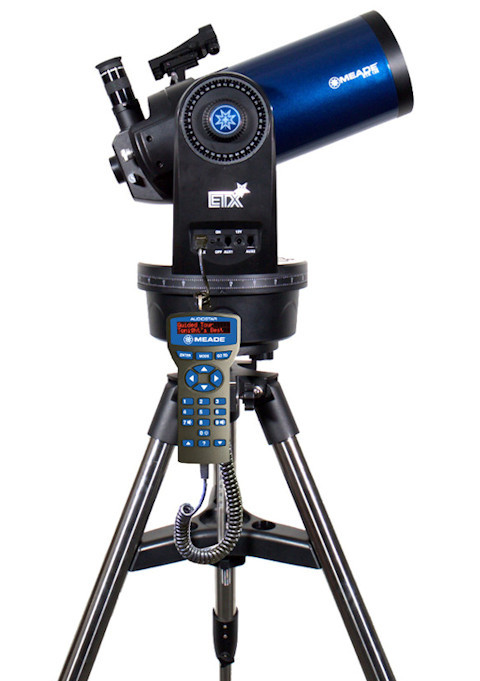
ETX125 Observer.
Meade LX65 series
The LX65 series telescopes feature premium optics and a newly designed single-arm mount with Meade’s latest AudioStar handset. The LX65 mount is compact yet sturdy, featuring two dovetail saddles that allow you to mount and use two optical tubes at once, for a chance to observe deep sky objects both in wide field or close up!
These telescopes come with a variety of optical tubes from 5-inch Maksutov-Cassegrains to 8-inch Meade’s latest ACF optical tubes. The LX65 series are ideal for general observation and for imaging the moon and planets; can also be used to a reasonable degree for deep sky imaging.
If you are more interested on the planets and the Moon, Maksutov-Cassegrain optical tubes would be ideal. On the other hand, if you need a more general-purpose telescope with high quality optics and a larger aperture the ACF optical tubes would be the better choice.
LX65 optical tubes use Meade’s Ultra High Transmission Coatings (UHTC) for the improvement of brighter star clusters, additional fine detail in nebulae, and greater surface features on planets. The Meade LX65 Series can be controlled from a PC, smartphone or tablet with the appropriate software and hardware available separately.
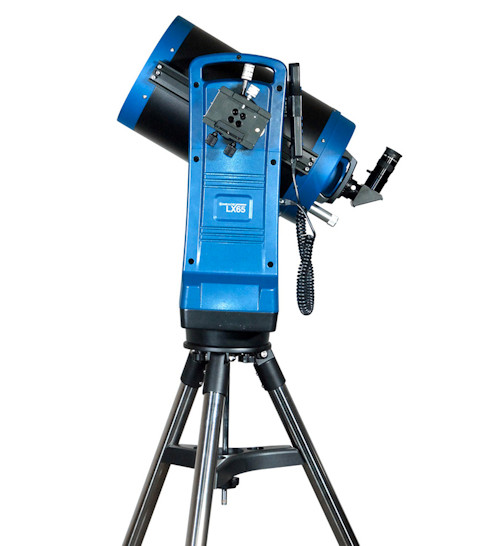
LX65 8-inch ACF.
Meade LightSwitch LS
For an easy to carry, set up and use telescope the Meade LightSwitch LS series would be the perfect choice. Their coma corrected ACF optics will readily outperform Schmidt Cassegrain (SCT) telescopes.
The computerised Meade LS Series are able of automatically aligning themselves at the flick of the power switch. Otherwise they can still be aligned semi-automatically like the Meade LX200 Series, this still only takes a few minutes.
Astronomer Inside takes you on a guided multimedia tour of the best objects in your sky using the optional Meade LS 3.5” colour LCD monitor making this telescope an educational tool.
The included AutoStar III GoTo handset has a 100,000+ object library and guided tour functions. The built-in Meade ECLIPS colour CCD camera (640x480 resolution) uses its own lens to capture wide field images of your favourite celestial wonders and display them in real time on the external colour LCD monitor (sold separately) or, store the images on an SD card (sold separately) so you can partake in CCD imaging early on.
The LightSwitch LS telescopes are very well suited for observation, planetary and Lunar imaging as well as for introductory deep sky imaging.
They come in 6-inch and 8-inch apertures and feature Meade’s ACF optical tube with Meade’s Ultra High Transmission Coatings (UHTC) for the improvement of brighter star clusters, additional fine detail in nebulae, and greater surface features on planets.

LightSwitch LS 8-inch ACF.
The LightSwitch LS Series can be controlled from a PC or iOS/Android tablet with the appropriate software and hardware available separately. In the case of the LS Series, these telescopes can be directly connected to a PC with a standard A/B USB cable.
Meade LX90 ACF series
The Meade LX90 ACF Series represents Meade’s workhorse Alt-azimuth mounted telescope. The GPS enabled LX90 ACF Series incorporates the same premium ACF optics as used in all Meade’s ACF telescopes and is available in 8-inch, 10-inch and 12-inch apertures.
The LX90 ACF is the ideal general-purpose telescope that is easy to upgrade and well suited for both visual work and imaging. If there was a need, it could be user upgraded via the addition of an equatorial wedge and auto-guide ST-4 type port for extended exposure times longer than most if not all astronomy cameras are capable of.
The LX90 ACF is the kind of telescope that will grow with you since it can be easily upgraded to a fully capable deep sky imaging platform as the need arises.
The LX90 ACF Series use Meade’s Ultra High Transmission Coatings (UHTC). They can be controlled from a Windows PC; or an iOS/Android smartphone or tablet with the appropriate software and hardware available separately.

LX90 8-inch ACF.
Meade equatorially mounted telescopes
Meade LX85 series
The LX85 Series telescopes feature a high-quality, portable, GoTo, 15Kg capacity German equatorial mount with the latest AudioStar computerised handset. The LX85 Series would be the perfect choice for the experienced observer and astro-imager looking to observe and specifically image deep sky objects out of the box with an optional camera and power source.
The LX85 Series telescopes come with a wide variety of optical tubes from 70mm to 8-inch apertures as outlined below.
The 5-inch achromatic refractor and 6-inch and 8-inch reflectors offer an affordable entry to deep sky imaging and are also well suited for observation. Note that the larger 6-inch and 8-inch aperture reflectors favour these telescopes when it comes to deep sky observation and especially imaging.
The 6-inch Maksutov-Cassegrain would be ideal for observing and imaging the Moon and planets but is also suited for deep sky observation and imaging to a good degree.
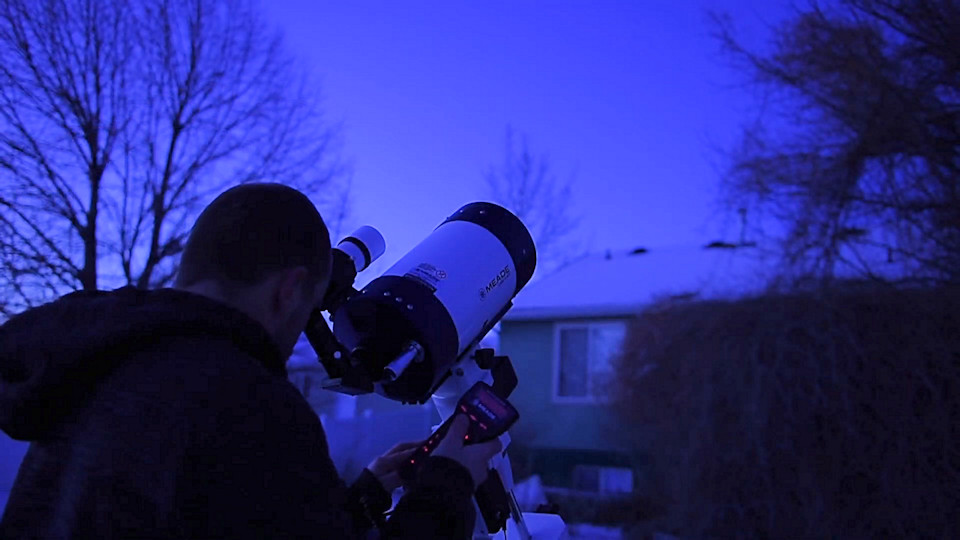
Meade LX85 6-inch Maksutov telescope.
The Meade Series 6000 triplet apochromatic (APO) refractors are individually constructed and tested to ensure that they meet the highest standards, both optically and mechanically. Available in 80mm, 115mm & 130mm apertures these telescopes use an apochromatic triplet to near eliminate chromatic aberrations and are ideal for wide field imaging and planetary observation. A field focal reducer/flattener is available for these telescopes. Expect maximum practical magnifications of around 60x per inch of aperture.
Also, part of the series is the 70mm Astrograph, a true quadruplet-element Petzval apochromatic refractor that has been designed and can only be used for imaging. The fully illuminated image circle is 42mm and will cover a 35mm full frame sensor
Finally, the 6-inch and 8-inch ACF make ideal instruments for observing and imaging in general whether Lunar, planetary or deep sky. The Maksutov Cassegrain and ACF benefit from Meade’s d Ultra High Transmission Coatings (UHTC) where the Newtonian reflector are SiO2 coated to protect the aluminium coated parabolic and secondary mirror surfaces. Finally, the Series 6000 APO refractors use Fluorite FPL 53 fully multicoated optics for maximum performance without compromises.
The Meade Series 6000 APO refractors, achromatic refractors, Newtonian reflectors, Maksutov-Cassegrain and ACF optical tubes are available separately or as complete telescopes.
The LX85 Series can be controlled from a PC or iOS/Android tablet with the appropriate software and hardware available separately.
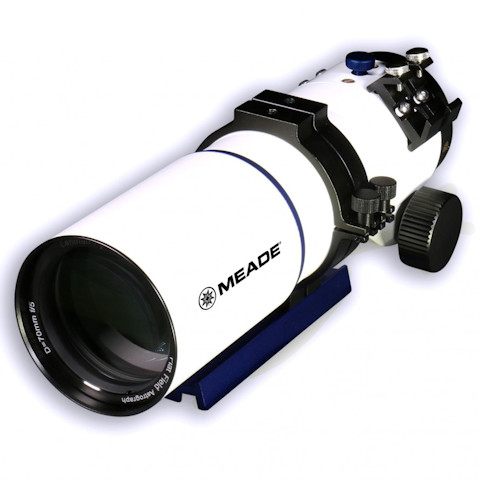
Series 6000 70mm APO Astrograph.
Meade LightBridge Dobsonian reflectors
The Meade LightBridge is a big telescope that goes anywhere. The LightBridge truss-dobs from Meade are easy to take down and set up quickly. Steel RA Roller Bearings are used, making movements smooth and effortless.
So, you can take one of these massive windows on the universe out to your favourite dark sky locations with relative ease.
LightBridge Dobsonians feature high quality Meade optics, premium components, and ultra-portability.
Meade supplies the LightBridge Series of manual Dobsonian reflectors in 10-inch, 12-inch and 16-inche apertures. These telescopes are well suited for observation and only suited for introductory Lunar and planetary imaging.
These manually controlled telescopes incorporate high quality reflecting optics and offer excellent value in terms of aperture. The BK7 aluminium coated parabolic mirror and secondary are MgF2 coated to protect and enhance the overall performance of the optics.
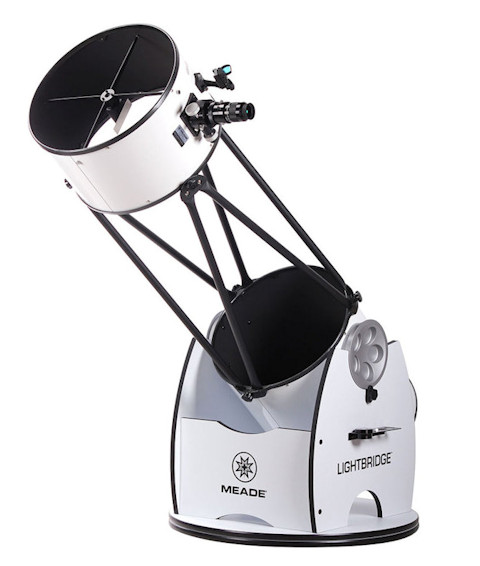
LightBridge Dobsonian reflector.
Standard accessories
Most of these complete telescopes and OTAs come with a range of optical accessories that may include a red dot view-finder or finder-scope, one or two standard eyepieces, a standard x2 barlow lens and a star diagonal where applicable. So, they could be used out of the box subject to having a way to power them e.g., batteries,
rechargeable power tank, appropriate mains power supply etc.
I essence you would need a view-finder or finder-scope with any telescope; you would also need a minimum three eyepieces to cover the magnification range, a diagonal if you are not using a Newtonian reflector telescope and a neutral density Moon filter.
Eyepieces
The three eyepieces should be chosen so as to provide minimum, average, and close to maximum magnifications. You could fill the gaps as you acquire more eyepieces and as the need arises. What eyepieces you add depends on your actual telescope and the maximum magnification it is capable of.
Higher quality eyepieces will deliver crisper images, wider fields of view and a brighter view depending on the quality of the optics, number of lenses within the eyepiece and coatings applied. Everything being equal, Fully Multi Coated (FMC) eyepieces will offer the best performance.
Remaining within the scope of this article you can calculate that maximum magnification per inch of aperture depending on the telescope type, optics quality, aperture and focal length and ratio.
For example, a 10-inch F/5 Newtonian reflector will have a maximum useful magnification of say 300x (10x30). A 4-inch APO refractor will have a maximum useful magnification of 240x (4x60).
Favourable sky conditions can push this a bit higher for an experienced observer.
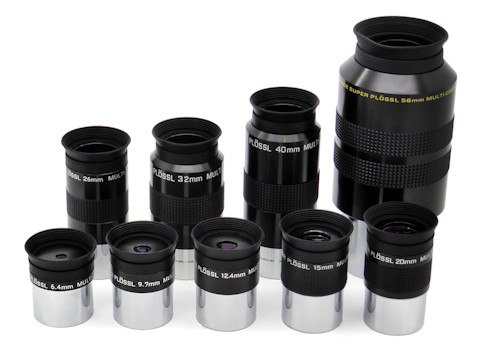
Meade Series 4000 Super Plossl eyepieces.
To obtain the correct focal length of an eyepiece that will offer the maximum useful magnification for a certain telescope you would need to divide the focal length of the telescope by the maximum useful magnification the design is capable of. Consider a 4-inch (102mm) F/6 apochromatic refractor with a focal length of 612mm (102x6) capable of 240x maximum useful magnification. To obtain the highest useful magnification for this scope you would need a 2.5mm eyepiece (612 / 240 = 2.5).
For more information on eyepieces, magnifications and fields of view please refer to the Choosing you First Telescope article (in the Links section below).
Moon and planetary filters
A Moon filter would be necessary to observe the Moon. A 25% transparency filter would suite instruments up to 5 inches in aperture where a 13% transparency filter would suite larger apertures.
Colour Filters are required to bring out additional detail on the surface of planets that would otherwise be very difficult or impossible to see. For example, filters will bring out contrast in the clouds of Jupiter and Saturn, show fine detail on the surface of Mars and make it easier to observe Venus. When you first use colour filters you will notice some difference but with practice you will see a lot more detail, especially at higher magnifications.
Barlow lenses and focal reducers
The optical characteristics of a telescope can be changed with certain accessories such as barlow lenses that increase a telescope’s focal length, focal reducers that reduce a telescope’s focal length and flatteners that will flatten the field of view for imaging purposes but these are outside the scope of this article.
Advanced accessories
All telescopes mentioned in this article can be connected and controlled via PC, iOS or Android smartphone / tablet with the exception of the manual LightBridge.
PC, iOS & Android connectivity
To directly connect an ETX Observer, LX65, LX85 or LX90 to a PC you will need the Meade #505 cable and USB to Serial adapter. To do the same with a LightSwitch telescopes you will need a standard A/B type USB cable instead.
Alternatively, all these telescopes can be controlled from an Apple iOS or Android device for which you will need the optional Safari 6 Plus/Pro software and Meade Stella WiFi adapter. In addition, the ETX Observer, LX65, LX85 and LX90 require the Meade #505 cable and USB to Serial adapter where the LightSwitch LS requires a standard A/B type USB cable to connect the Stella WiFi adapter to the telescope. For more information please refer to the article headed Remote Control for Meade Telescopes (in the Links section below).
Cameras
Meade supplies a number of cameras including the LPI-G video cameras and cooled DSI-IV single shot deep sky cameras. These come in colour and monochrome versions, monochrome versions of the same model being 2.5 to 3 times more light sensitive than the colour equivalent.

Meade dedicated astronomy cameras from left to right: LPI-G Monochrome, LPI-G Colour,
LPI-G Advanced Colour, LPI-G Advanced Monochrome, DSI-IV Colour and DSI-IV Monochrome.
Dedicated video and single shot astronomy cameras can be attached to any telescope mentioned in this article as can a DSLR camera. However, care needs to be taken when attaching heavier cameras to the ETX80/90 Observer and StarNavigator NG series like the Meade DSI-IV or a heavier DSLR.
A video camera like the LPI-G Series can used to observe in real-time and also capture images and video of the Moon and planets where a single shot camera like the DS-IV is capable of extended exposures will be able to capture deep objects in full colour or in monochrome.
When used as an auto-guider, a monochrome LPI-G video camera will be able to auto-guide on fainter stars. Equally, a monochrome camera will pick up significantly more detail when imaging deep sky objects or the Sun with a dedicated Solar scope like the Coronado PST or SolarMax when compared to the colour equivalent.
LRGB (luminosity, red, green, blue) colour filters can be used to compose colour images with a monochrome camera or false colour images like those of the Hubble space telescope with narrow band filters.
Caution: Please note that if you do not use a dedicated Coronado Solar scope, Solar filers used with astronomical telescopes must cover the whole aperture to protect both the optics of your telescope and the observer’s eyes. Never look directly or point your telescope towards the Sun without adequate protection. This is a complex subject to cover and if you are not certain please contact us for advice.
Auto-guiding
All telescopes mentioned in this article with the exception of the manual LightBridge are capable of automatically locating and accurately tracking Celestial objects, offering the ability to capture images using a standard digital or dedicated astronomy camera to various degrees.
Equatorially mounted telescopes like the Meade LX85 can take advantage of auto-guiding to extended exposures typically beyond the capabilities of today’s astronomy cameras, also eliminating field rotation since they are equatorially mounted. A guide-scope and auto-guide camera, available separately, are required e.g., Meade Series 6000 Guide Scope and Meade LPI-G camera.
Note that the LX85 Series telscopes have a built-in ST-4 type port out-of-the-box. LX90 ACF Series support auto-guiding with the addition of the optional Meade Auto-guide port Module seen on the right and equatorial wedge.
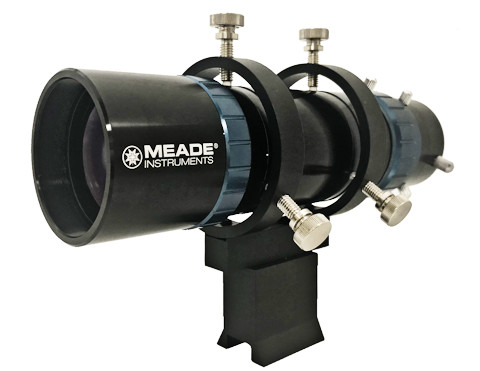
Series 6000 Guide-scope.
All telescopes mentioned in this article with the exception of the manual LightBridge are capable of automatically locating and accurately tracking Celestial objects, offering the ability to capture images using a standard digital or dedicated astronomy camera to various degrees.
Otherwise, the StarNavigator NG Series, ETX Observer Series, LX65 Series and LightSwitch LS ACF do not come with an ST-4 type Auto-guide port and one cannot be added.
For completeness, the Meade LX200 ACF, LX600 ACF and LX850 Series come with an auto-guide ST-4 type port.
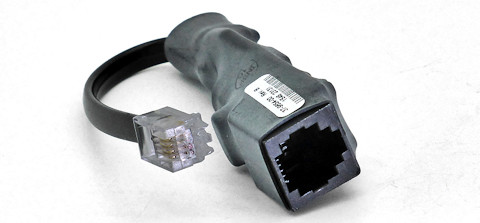
LX90 Guide Port Module.
Conclusion
Alt-azimuth mounted telescopes are typically easier to setup and align when compared to equatorially mounted telescopes. But, once aligned they are both as easy to operate. The main advantage of equatorially mounted telescopes is that they are necessary for serious deep sky imaging.
With reference to deep sky imaging, some Alt-azimuth mounted telescopes can still be equatorially mounted for which you would need a wedge. All types of equatorially mounted telescopes with an ST-4 type port can further benefit from auto-guiding for which you would need a small 50mm-70mm refractor attached to the telescope and also auto-guide camera. This will typically extend exposure times beyond the capabilities of a dedicated deep sky camera.
The following table outlines the basic characteristics of Alt-azimuth and equatorially mounted telescopes. This table should only be used as a general guide and should contact us for advice if uncertain.
| Mount |
Alignment |
Planetary &
Lunar Imaging |
Deep Sky
Imaging |
GOTO |
Auto-guide |
Remote Control |
| ETX125 |
easy-average*** |
excellent |
good |
yes |
n.a. |
yes* |
| LX65 |
easy |
excellent |
introductory |
yes |
n.a. |
yes* |
| LX85 |
average |
excellent |
excellent |
yes |
optional |
yes* |
| LX90 |
easy-average*** |
excellent |
good-excellent |
yes |
optional |
yes* |
| LightSwitch LS |
automatic** |
excellent |
introductory |
yes |
n.a. |
yes* |
| LightBridge |
n.a. |
basic |
n.a. |
n.a. |
n.a. |
n.a. |
* Can be controlled from a PC running Microsoft Windows with the appropriate software. You will need the optional #505 cable and USB to Serial
Adapter. Alternatively, the mount can be controlled from an Apple iOS or Android device for which you will need the
optional Safari 6 Plus/Pro software, the Meade Stella WiFi adapter and #505 cable.
** Can be controlled from a PC with the appropriate software and optional A/B USB cable. Alternatively, the LS
can be controlled from an Apple iOS or Android device for which you will need the optional Safari 6 Plus/Pro
software, the Meade Stella WiFi adapter and an A/B USB cable.
*** This depends on whether the telescope is set to Alt-azimuth (easy) or equatorial mode.
|
Meade offers a wide choice of telescopes including refractors, reflectors and catadioptrics on a range of German equatorial, Alt-azimuth and Dobsonian mounts. Larger aperture telescopes will show more but are bulkier and heavier.
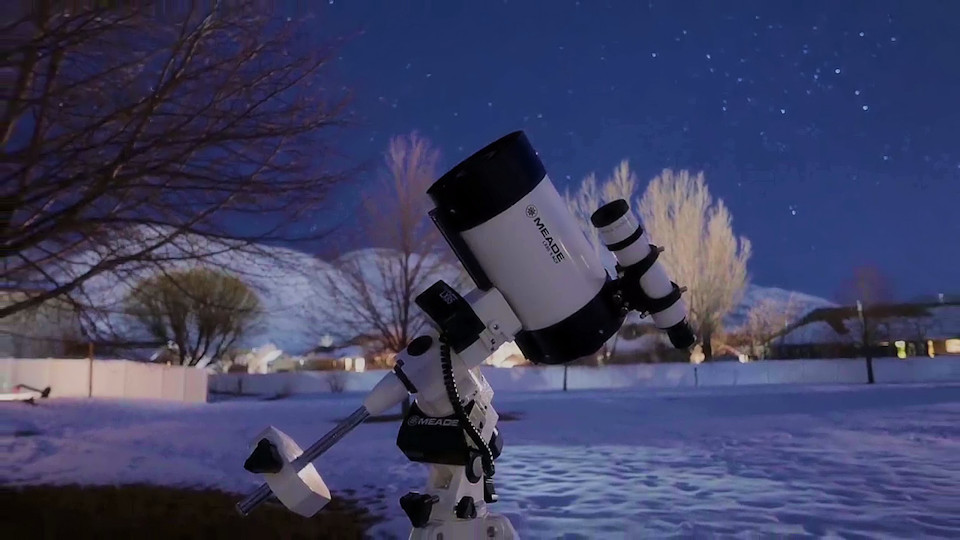
Meade LX85 6-inch ACF.
| Telescope Design |
Visual |
Imaging |
Cooling Time |
Need to Collimate |
Upkeep |
| Newtonian reflector |
good |
good |
20 minutes |
often |
required |
| SCT |
good |
good |
30 minutes |
very rare |
very little |
| Meade ACF |
very good |
very good |
30 minutes |
very rare |
very little |
| Maksutov-Cassegrain |
very good |
very good |
45 minutes |
very rare |
very little |
| Achromatic refractor |
good |
good |
15 minutes |
extremely rare |
minimal |
| APO Triplet refractor |
excellent |
excellent |
20 minutes |
extremely rare |
minimal |
In Alt-azimuth mount terms the Meade ETX125 Observer and LightSwitch LS scopes are not difficult to transport, especially the ETX 125 Observer. The LX85 are relatively easy to transport since they can be split in terms of the tripod, mount-head, optical tube and counter-weights. The same would apply to the Meade truss-tube Dobsonian telescopes and LX65 since they can also be easily split in their parts.
The Meade LX90 Series are more difficult to transport since they can only be split in two parts, the tripod and fork-mounted optical tube assembly. While the 8-inch is manageable the larger 10-inch and 12-inch would be more challenging but still within a capability of most adults.
The LX85 Series support auto-guiding out-of-the-box and have an ST-4 type port. The LX90 ACF Series support auto-guiding with the addition of the optional Meade Auto-guide Port Module and equatorial wedge.
Related topics:
article, ETX125 Observer, LS LightSwitch, LX65, LX85, LX90








